Divorced at 50 and Never Married Again
Age
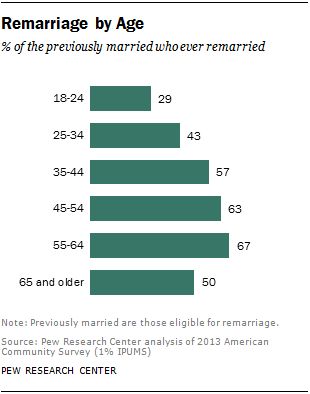 Remarriage is on the rise for Americans ages 55 and older, even as younger generations who accept taken the plunge once are becoming less likely to have remarried. What has not inverse is that older adults remain more likely to have remarried than their younger counterparts.
Remarriage is on the rise for Americans ages 55 and older, even as younger generations who accept taken the plunge once are becoming less likely to have remarried. What has not inverse is that older adults remain more likely to have remarried than their younger counterparts.
Remarriage generally becomes more common with age—not surprising, given that it takes some time to enter into one matrimony, go out that marriage and so enter into a subsequent one.7 Only 29% of previously married adults ages 18 to 24 (admittedly a pocket-sized group) had remarried in 2013, compared with 67% of those ages 55 to 64.
But the likelihood of having remarried has dropped sharply for those younger than 35. Amidst the small group of immature adults who had already exited their first marriage, fully 72% had remarried past 1960. In 2013, only 42% of young adults who had been divorced or widowed had remarried.
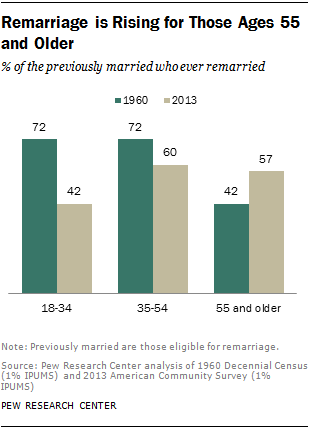 Over that same time period, the share of previously married adults ages 35 to 44 who had remarried dropped substantially (from 76% to 57%), and the share who had remarried amongst those ages 45 to 54 declined modestly (from 69% to 63%).
Over that same time period, the share of previously married adults ages 35 to 44 who had remarried dropped substantially (from 76% to 57%), and the share who had remarried amongst those ages 45 to 54 declined modestly (from 69% to 63%).
The trend in remarriage among adults ages 55 and older has gone in the reverse management. In 2013, two-thirds (67%) of previously married adults ages 55 to 64 had remarried, upwards from 55% in 1960. And 50% of adults ages 65 and older had remarried, upward from just 34% in 1960. These increases may in function be fueled by rising life expectancies. Some suggest that longer lifespans have contributed to increasing divorce at older ages as people realize they take many more years to live and desire to detect fulfillment in that extra time. The same factor may be contributing to increases in remarriage amongst older adults.8
Gender Gap in Remarriage
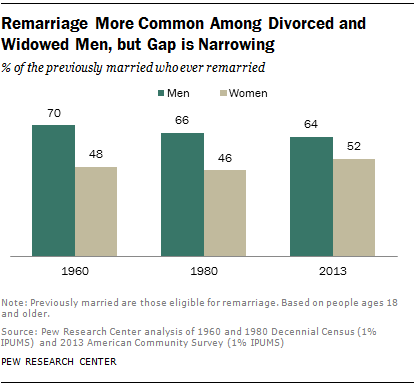 Amid those eligible to remarry—adults whose first wedlock ended in divorce or widowhood—men are much more than likely than women to accept taken the plunge once again. In 2013, some 64% of eligible men had remarried, compared with 52% of women.ix
Amid those eligible to remarry—adults whose first wedlock ended in divorce or widowhood—men are much more than likely than women to accept taken the plunge once again. In 2013, some 64% of eligible men had remarried, compared with 52% of women.ix
This may reflect, in part, the fact that men who have been divorced or widowed are more likely to want to remarry than are similarly situated women. Some 29% of eligible men say they want to remarry, and 36% are not certain, according to a recent Pew Inquiry Centre survey; only 30% say they exercise not want to marry once again. In contrast, just 15% of previously married women desire to remarry, and 27% are not sure; about half of these women (54%) study that they do not want to remarry.
While the gender gap in the likelihood to marry again is notable, it has narrowed over time, equally men have become somewhat less probable to remarry, and women take become somewhat more likely to exercise so. Today's 12-bespeak gap was a 20-point gap in 1980, when 66% of eligible men and 46% of women had remarried. In 1960, the gap was even larger—70% of eligible men had remarried, compared with 48% of women.
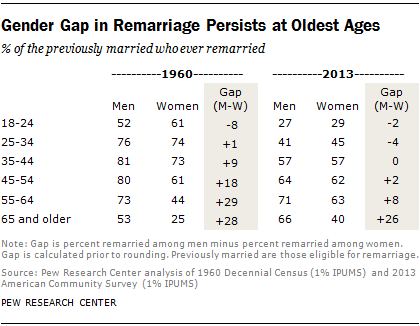 The gender gap has closed mainly amongst younger and heart-aged adults who are eligible to remarry. Divorced or widowed women ages 25 to 54 are now virtually as likely every bit men in that age range to have remarried. Among those ages 55 and older, the gap remains substantial.
The gender gap has closed mainly amongst younger and heart-aged adults who are eligible to remarry. Divorced or widowed women ages 25 to 54 are now virtually as likely every bit men in that age range to have remarried. Among those ages 55 and older, the gap remains substantial.
Looking at educational attainment, the gender gap persists beyond groups merely has narrowed about dramatically amid those with a bachelor's degree. In 1960, amidst college graduates, only xl% of divorced or widowed women had remarried, compared with 75% of men. By 2013, that share had risen to 52% among women, but had fallen to 67% amongst men. In less-educated groups, remarriage among women has remained stable during this fourth dimension period, while it has declined markedly among men.
Race and Ethnicity
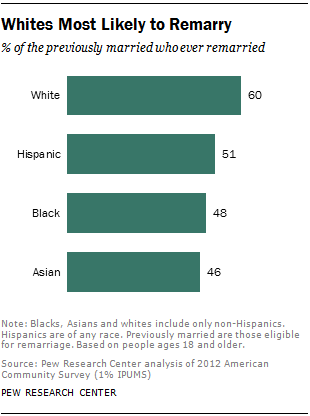 Amongst adults who have been divorced or widowed and are thus eligible to remarry, whites are the most likely to have married again, and this likelihood has increased somewhat in contempo decades.ten Past dissimilarity, previously married Hispanic, black and Asian adults are less likely to accept remarried than in the past. These patterns mirror those seen in rates of first union, where whites are more than likely than blacks or Hispanics to enter into union for the first fourth dimension.11
Amongst adults who have been divorced or widowed and are thus eligible to remarry, whites are the most likely to have married again, and this likelihood has increased somewhat in contempo decades.ten Past dissimilarity, previously married Hispanic, black and Asian adults are less likely to accept remarried than in the past. These patterns mirror those seen in rates of first union, where whites are more than likely than blacks or Hispanics to enter into union for the first fourth dimension.11
In 2012, six-in-ten whites who had been married before had remarried, compared with 51% of Hispanics, 48% of blacks, and 46% of Asians. Age composition is playing a role in these patterns—the fact that whites tend to be older may contribute to their higher likelihood of remarriage, for instance. However, some racial and indigenous differences persist, even decision-making for age.
Over time, the share of previously married whites who remarry has increased somewhat, upwardly from 55% in 1960. In contrast, remarriage has declined since 1960 for non-whites and Hispanics. At that time, 63% of blacks, 62% of Hispanics and 49% of Asians had remarried.
The increasing prevalence of remarriage amid whites is driven entirely by increases among white women. In 1960, 47% of divorced or widowed white women had remarried, and this share rose to 55% past 2012. By contrast, the share of previously married white men who remarried declined from 69% to 66% over that same time period. For all other racial and indigenous groups, both men and women were less probable remarry in 2012 compared with 1960.
Looking at all currently married adults, one-fourth of whites (26%) and blacks (25%) had been married previously in 2012. This share was lower amongst married Hispanics (16%) and Asians (10%).
Birth
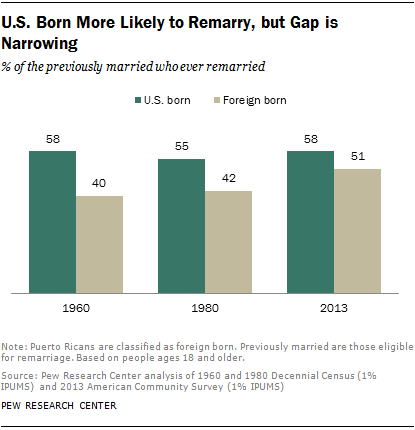 Among adults who are eligible to remarry, those built-in in the U.South. are more likely to do so than those built-in exterior of the U.Southward., only the gap has narrowed over fourth dimension as immigrants accept become more likely to remarry.12 In 2013, 58% of divorced or widowed U.S.-built-in adults had remarried, compared with 51% among the strange born. In 1960, those shares were 58% and 40%, respectively, and in 1980, the shares were 55% among the U.Southward. born and 42% amidst the foreign built-in.
Among adults who are eligible to remarry, those built-in in the U.South. are more likely to do so than those built-in exterior of the U.Southward., only the gap has narrowed over fourth dimension as immigrants accept become more likely to remarry.12 In 2013, 58% of divorced or widowed U.S.-built-in adults had remarried, compared with 51% among the strange born. In 1960, those shares were 58% and 40%, respectively, and in 1980, the shares were 55% among the U.Southward. born and 42% amidst the foreign built-in.
Among all married adults, well-nigh a quarter (26%) of those born in the U.Southward. are remarried, compared with 14% of strange-built-in adults.
Serial Remarriage: Who Has Married Iii Times or More?
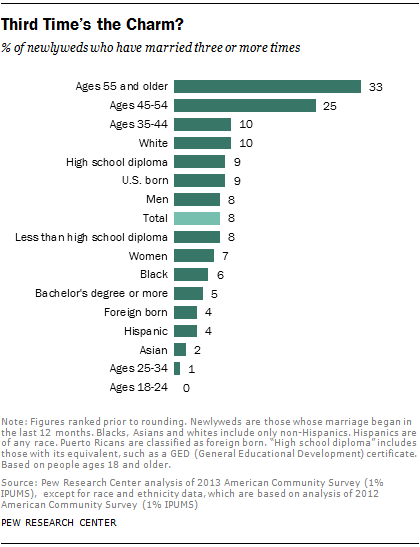 Among newly married adults in 2013 (those who had wed in the past 12 months), 29% had been married at least once before, and 8% had been married two or more times previously. Older newlyweds are amid those virtually probable to be entering their 3rd marriage. Fully 33% of those ages 55 and older fall into this category, equally do 25% of those ages 45 to 54.
Among newly married adults in 2013 (those who had wed in the past 12 months), 29% had been married at least once before, and 8% had been married two or more times previously. Older newlyweds are amid those virtually probable to be entering their 3rd marriage. Fully 33% of those ages 55 and older fall into this category, equally do 25% of those ages 45 to 54.
Non surprising, newly married adults younger than 45 were much less likely to be entering into (at least) their tertiary marriage.
Newlyweds with merely a high school diploma are most twice as likely equally those with a bachelor's degree to be entering their third marriage (9% vs. v%, respectively). Some eight% of newlyweds without a loftier school diploma accept been married at least twice earlier.
Ten percent of white newlyweds have been married at least twice before, compared with 6% of blacks, four% of Hispanics and just two% of Asians.
Native-born newlyweds are twice as likely as strange-born newlyweds to be entering a third (or higher social club) union. 9 percent are doing then, compared with simply 4% among the foreign born.
Source: https://www.pewresearch.org/social-trends/2014/11/14/chapter-2-the-demographics-of-remarriage/
0 Response to "Divorced at 50 and Never Married Again"
ارسال یک نظر